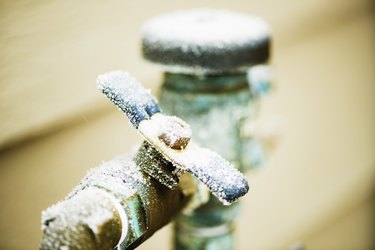How to Safeguard Pipes from Freezing: Specialist Guidance
How to Safeguard Pipes from Freezing: Specialist Guidance
Blog Article
Listed here underneath you can get some very good insights pertaining to Winter Plumbing Precautions: Preventing Frozen Pipes.
:strip_icc()/snow-outdoor-faucet-pipes-4af65d1e5e904fb1aa7bf74071fe5d89.jpg)
Cold weather can damage your pipes, especially by freezing pipelines. Right here's just how to stop it from occurring and what to do if it does.
Intro
As temperature levels decrease, the risk of icy pipelines boosts, potentially bring about costly repair work and water damage. Comprehending just how to prevent frozen pipes is vital for home owners in cold climates.
Understanding Frozen Pipes
What causes pipes to freeze?
Pipelines ice up when revealed to temperature levels listed below 32 ° F (0 ° C) for expanded durations. As water inside the pipes freezes, it broadens, putting pressure on the pipe wall surfaces and possibly triggering them to rupture.
Risks and damages
Icy pipes can result in supply of water disruptions, residential or commercial property damage, and pricey repair work. Ruptured pipelines can flood homes and trigger comprehensive architectural damage.
Signs of Frozen Water Lines
Identifying icy pipelines early can avoid them from breaking.
How to recognize frozen pipes
Seek decreased water circulation from taps, unusual odors or sounds from pipelines, and visible frost on subjected pipelines.
Avoidance Tips
Insulating susceptible pipelines
Cover pipelines in insulation sleeves or utilize heat tape to shield them from freezing temperatures. Focus on pipes in unheated or exterior areas of the home.
Heating strategies
Maintain interior rooms sufficiently heated up, specifically areas with pipes. Open cupboard doors to permit warm air to distribute around pipelines under sinks.
Securing Exterior Plumbing
Garden tubes and outdoor faucets
Detach and drain pipes yard hoses before wintertime. Mount frost-proof faucets or cover outdoor taps with protected caps.
What to Do If Your Pipes Freeze
Immediate actions to take
If you think icy pipelines, keep taps open to relieve pressure as the ice melts. Utilize a hairdryer or towels taken in warm water to thaw pipelines gradually.
Long-Term Solutions
Architectural adjustments
Consider rerouting pipes away from exterior walls or unheated areas. Add extra insulation to attics, cellars, and crawl spaces.
Updating insulation
Buy high-grade insulation for pipes, attics, and walls. Proper insulation aids keep constant temperatures and decreases the risk of icy pipelines.
Final thought
Preventing icy pipes requires aggressive procedures and quick responses. By understanding the causes, signs, and safety nets, home owners can protect their plumbing during cold weather.
5 Ways to Prevent Frozen Pipes
Drain Outdoor Faucets and Disconnect Hoses
First, close the shut-off valve that controls the flow of water in the pipe to your outdoor faucet. Then, head outside to disconnect and drain your hose and open the outdoor faucet to allow the water to completely drain out of the line. Turn off the faucet when done. Finally, head back to the shut-off valve and drain the remaining water inside the pipe into a bucket or container. Additionally, if you have a home irrigation system, you should consider hiring an expert to clear the system of water each year.
Insulate Pipes
One of the best and most cost-effective methods for preventing frozen water pipes is to wrap your pipes with insulation. This is especially important for areas in your home that aren’t exposed to heat, such as an attic. We suggest using foam sleeves, which can typically be found at your local hardware store.
Keep Heat Running at 65
Your pipes are located inside your walls, and the temperature there is much colder than the rest of the house. To prevent your pipes from freezing, The Insurance Information Institute suggests that you keep your home heated to at least 65 degrees, even when traveling. You may want to invest in smart devices that can keep an eye on the temperature in your home while you’re away.
Leave Water Dripping
Moving water — even a small trickle — can prevent ice from forming inside your pipes. When freezing temps are imminent, start a drip of water from all faucets that serve exposed pipes. Leaving a few faucets running will also help relieve pressure inside the pipes and help prevent a rupture if the water inside freezes.
Open Cupboard Doors
Warm your kitchen and bathroom pipes by opening cupboards and vanities. You should also leave your interior doors ajar to help warm air circulate evenly throughout your home.

I am just very focused on 6 Ways to Prevent Frozen Pipes and I am praying you appreciated our article. Do you know someone else who is occupied with the niche? Feel free to share it. Thanks a bunch for being here. Please stop by our blog back soon.
Request Free Estimate Report this page